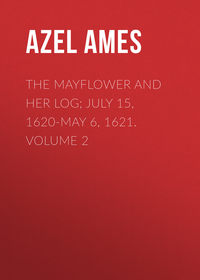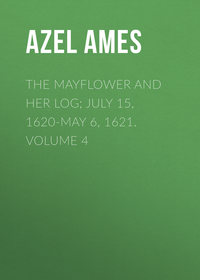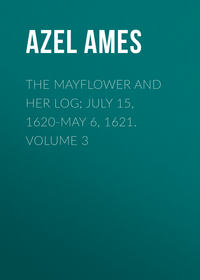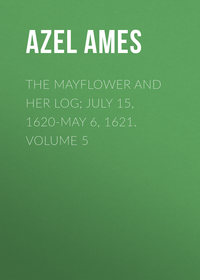 полная версия
полная версияThe Mayflower and Her Log; July 15, 1620-May 6, 1621. Volume 1
Rev. Edward Everett Hale, in "The Pilgrims' Life in Common," says: "Carver, Winslow, Bradford, Brewster, Standish, Fuller, and Allerton. were the persons of largest means in the Leyden group of the emigrants. It seems as if their quota of subscription to the common stock were paid in 'provisions' for the voyage and the colony, and that by 'provisions' is meant such articles of food as could be best bought in Holland." The good Doctor is clearly in error, in the above. Allerton was probably as "well off" as any of the Leyden contingent, while Francis Cooke and Degory Priest were probably "better off" than either Brewster or Standish, who apparently had little of this world's goods. Neither is there any evidence that any considerable amount of "provision" was bought in Holland. Quite a large sum of money, which came, apparently, from the pockets of the Leyden Adventurers (Pickering, Greene, etc.), and some of the Pilgrims, was requisite to pay for the SPEEDWELL and her refitting, etc.; but how much came from either is conjectural at best. But aside from "Hollands cheese," "strong-waters" (schnapps), some few things that Cushman names; and probably a few others, obtained in Holland, most of the "provisioning," as repeatedly appears, was done at the English Southampton. In fact, after clothing and generally "outfitting" themselves, it is pretty certain that but few of the Leyden party had much left. There was evidently an understanding between the partners that there should be four principal agents charged with the preparations for, and carrying out of, the enterprise,—Thomas Weston and Christopher Martin representing the Adventurers and the colonists who were recruited in England (Martin being made treasurer), while Carver and Cushman acted for the Leyden company. John Pierce seems to have been the especial representative of the Adventurers in the matter of the obtaining of the Patent from the (London) Virginia Company, and later from the Council for New England. Bradford says: "For besides these two formerly mentioned, sent from Leyden, viz., Master Carver and Robert Cushman, there was one chosen in England to be joyned with them, to make the provisions for the Voyage. His name was Master Martin. He came from Billerike in Essexe; from which parts came sundry others to go with them; as also from London and other places, and therefore it was thought meet and convenient by them in Holand, that these strangers that were to goe with them, should appointe one thus to be joyned with them; not so much from any great need of their help as to avoid all susspition, or jealosie, of any partialitie." But neither Weston, Martin, Carver, nor Cushman seems to have been directly concerned in the purchase of the SPEEDWELL. The most probable conjecture concerning it is, that in furtherance of the purpose of the Leyden leaders, stated by Bradford, that there should be a small vessel for their service in fishing, traffic, etc., wherever they might plant the colony, they were permitted by the Adventurers to purchase the SPEEDWELL for that service, and as a consort, "on general account."
It is evident, however, from John Robinson's letter of June 14, 1620, to John Carver, that Weston ridiculed the transaction, probably on selfish grounds, but, as events proved, not without some justification.
Robinson says: "Master Weston makes himself merry with our endeavors about buying a ship," [the SPEEDWELL] "but we have done nothing in this but with good reason, as I am persuaded." Although bought with funds raised in Holland,
[Arber (The Story of the Pilgrim Fathers, p. 341) arrives at the conclusion that "The SPEEDWELL had been bought with Leyden money. The proceeds of her sale, after her return to London, would, of course, go to the credit of the common joint-Stock there." This inference seems warranted by Robinson's letter of June 16/26 to Carver, in which he clearly indicates that the Leyden brethren collected the "Adventurers" subscriptions of Pickering and his partner (Greene), which were evidently considerable.]
it was evidently upon "joint-account," and she was doubtless so sold, as alleged, on her arrival in September, at London, having proved unseaworthy. In fact, the only view of this transaction that harmonizes with the known facts and the respective rights and relations of the parties is, that permission was obtained (perhaps through Edward Pickering, one of the Adventurers, a merchant of Leyden, and others that the Leyden leaders should buy and refit the consort, and in so doing might expend the funds which certain of the Leyden Pilgrims were to pay into the enterprise, which it appears they did,—and for which they would receive, as shown, extra shares in the Planters' half-interest. It was very possibly further permitted by the Adventurers, that Mr. Pickering's and his partners' subscriptions to their capital stock should be applied to the purchase of the SPEEDWELL, as they were collected by the Leyden leaders, as Pastor Robinson's letter of June 14/24 to John Carver, previously noted, clearly shows.
She was obviously bought some little time before May 31, 1620,—probably in the early part of the month,—from the fact that in their letter of May 31st to Carver and Cushman, then in London, Messrs. Fuller, Winslow, Bradford, and Allerton state that "we received divers letters at the coming of Master Nash and our Pilott," etc. From this it is clear that time enough had elapsed, since their purchase of the pinnace, for their messenger (Master Nash) to go to London,—evidently with a request to Carver and Cushman that they would send over a competent "pilott" to refit her, and for Nash to return with him, while the letter announcing their arrival does not seem to have been immediately written.
The writers of the above-mentioned letter use the words "we received,"– using the past tense, as if some days before, instead of "we have your letters," or "we have just received your letters," which would rather indicate present, or recent, time. Probably some days elapsed after the "pilott's" arrival, before this letter of acknowledgment was sent. It is hence fair to assume that the pinnace was bought early in May, and that no time was lost by the Leyden party in preparing for the exodus, after their negotiations with the Dutch were "broken off" and they had "struck hands" with Weston, sometime between February 2/12, 1619/20, and April 1/11, 1620,—probably in March.
The consort was a pinnace—as vessels of her class were then and for many years called—of sixty tons burden, as already stated, having two masts, which were put in—as we are informed by Bradford, and are not allowed by Professor Arber to forget—as apart of her refitting in Holland. That she was "square-rigged," and generally of the then prevalent style of vessels of her size and class, is altogether probable. The name pinnace was applied to vessels having a wide range in tonnage, etc., from a craft of hardly more than ten or fifteen tons to one of sixty or eighty. It was a term of pretty loose and indefinite adaptation and covered most of the smaller craft above a shallop or ketch, from such as could be propelled by oars, and were so fitted, to a small ship of the SPEEDWELL'S class, carrying an armament.
None of the many representations of the SPEEDWELL which appear in historical pictures are authentic, though some doubtless give correct ideas of her type. Weir's painting of the "Embarkation of the Pilgrims," in the Capitol at Washington (and Parker's copy of the same in Pilgrim Hall, Plymouth); Lucy's painting of the "Departure of the Pilgrims," in Pilgrim Hall; Copes great painting in the corridor of the British Houses of Parliament, and others of lesser note, all depict the vessel on much the same lines, but nothing can be claimed for any of them, except fidelity to a type of vessel of that day and class. Perhaps the best illustration now known of a craft of this type is given in the painting by the Cuyps, father and son, of the "Departure of the Pilgrims from Delfshaven," as reproduced by Dr. W. E. Griffis, as the frontispiece to his little monograph, "The Pilgrims in their Three Homes." No reliable description of the pinnace herself is known to exist, and but few facts concerning her have been gleaned. That she was fairly "roomy" for a small number of passengers, and had decent accommodations, is inferable from the fact that so many as thirty were assigned to her at Southampton, for the Atlantic voyage (while the MAY-FLOWER, three times her tonnage, but of greater proportionate capacity, had but ninety), as also from the fact that "the chief [i.e. principal people] of them that came from Leyden went in this ship, to give Master Reynolds content." That she mounted at least "three pieces of ordnance" appears by the testimony of Edward Winslow, and they probably comprised her armament.
We have seen that Bradford notes the purchase and refitting of this "smale ship of 60 tune" in Holland. The story of her several sailings, her "leakiness," her final return, and her abandonment as unseaworthy, is familiar. We find, too, that Bradford also states in his "Historie," that "the leakiness of this ship was partly by her being overmasted and too much pressed with sails." It will, however, amaze the readers of Professor Arber's generally excellent "Story of the Pilgrim Fathers," so often referred to herein, to find him sharply arraigning "those members of the Leyden church who were responsible for the fitting of the SPEEDWELL," alleging that "they were the proximate causes of most of the troubles on the voyage [of the MAY-FLOWER] out; and of many of the deaths at Plymouth in New England in the course of the following Spring; for they overmasted the vessel, and by so doing strained her hull while sailing." To this straining, Arber wholly ascribes the "leakiness" of the SPEEDWELL and the delay in the final departure of the MAYFLOWER, to which last he attributes the disastrous results he specifies. It would seem that the historian, unduly elated at what he thought the discovery of another "turning-point of modern history," endeavors to establish it by such assertions and such partial references to Bradford as would support the imaginary "find." Briefly stated, this alleged discovery, which he so zealously announces, is that if the SPEEDWELL had not been overmasted, both she and the MAY-FLOWER would have arrived early in the fall at the mouth of the Hudson River, and the whole course of New England history would have been entirely different. Ergo, the "overmasting" of the SPEEDWELL was a "pivotal point in modern history." With the idea apparently of giving eclat to this announcement and of attracting attention to it, he surprisingly charges the responsibility for the "overmasting" and its alleged dire results upon the leaders of the Leyden church, "who were," he repeatedly asserts, "alone responsible." As a matter of fact, however, Bradford expressly states (in the same paragraph as that upon which Professor Arber must wholly base his sweeping assertions) that the "overmasting" was but "partly" responsible for the SPEEDWELL'S leakiness, and directly shows that the "stratagem" of her master and crew, "afterwards," he adds, "known, and by some confessed," was the chief cause of her leakiness.
Cushman also shows, by his letter,—written after the ships had put back into Dartmouth,—a part of which Professor Arber uses, but the most important part suppresses, that what he evidently considers the principal leak was caused by a very "loose board" (plank), which was clearly not the result of the straining due to "crowding sail," or of "overmasting." (See Appendix.)
Moreover, as the Leyden chiefs were careful to employ a presumably competent man ("pilott," afterwards "Master" Reynolds) to take charge of refitting the consort, they were hence clearly, both legally and morally, exempt from responsibility as to any alterations made. Even though the "overmasting" had been the sole cause of the SPEEDWELL'S leakiness, and the delays and vicissitudes which resulted to the MAY-FLOWER and her company, the leaders of the Leyden church—whom Professor Arber arraigns —(themselves chiefly the sufferers) were in no wise at fault! It is clear, however, that the "overmasting" cut but small figure in the case; "confessed" rascality in making a leak otherwise, being the chief trouble, and this, as well as the "overmasting," lay at the door of Master Reynolds.
Even if the MAY-FLOWER had not been delayed by the SPEEDWELL'S condition, and both had sailed for "Hudson's River" in midsummer, it is by no means certain that they would have reached there, as Arber so confidently asserts. The treachery of Captain Jones, in league with Gorges, would as readily have landed them, by some pretext, on Cape Cod in October, as in December. But even though they had landed at the mouth of the Hudson, there is no good reason why the Pilgrim influence should not have worked north and east, as well as it did west and south, and with the Massachusetts Bay Puritans there, Roger Williams in Rhode Island, and the younger Winthrop in Connecticut, would doubtless have made New England history very much what it has been, and not, as Professor Arber asserts, "entirely different."
The cruel indictment fails, and the imaginary "turning point in modern history," to announce which Professor Arber seems to have sacrificed so much, falls with it.
The Rev. Dr. Griffis ("The Pilgrims in their Three Homes," p. 158) seems to give ear to Professor Arber's untenable allegations as to the Pilgrim leaders' responsibility for any error made in the "overmasting" of the SPEEDWELL, although he destroys his case by saying of the "overmasting:" "Whether it was done in England or Holland is not certain." He says, unhappily chiming in with Arber's indictment: "In their eagerness to get away promptly, they [the Leyden men] made the mistake of ordering for the SPEEDWELL heavier and taller masts and larger spars than her hull had been built to receive, thus altering most unwisely and disastrously her trim." He adds still more unhappily: "We do not hear of these inveterate landsmen and townsfolk [of whom he says, 'possibly there was not one man familiar with ships or sea life'] who were about to venture on the Atlantic, taking counsel of Dutch builders or mariners as to the proportion of their craft." Why so discredit the capacity and intelligence of these nation-builders? Was their sagacity ever found unequal to the problems they met? Were the men who commanded confidence and respect in every avenue of affairs they entered; who talked with kings and dealt with statesmen; these diplomats, merchants, students, artisans, and manufacturers; these men who learned law, politics, state craft, town building, navigation, husbandry, boat-building, and medicine, likely to deal negligently or presumptuously with matters upon which they were not informed? Their first act, after buying the SPEEDWELL, was to send to England for an "expert" to take charge of all technical matters of her "outfitting," which was done, beyond all question, in Holland. What need had they, having done this (very probably upon the advice of those experienced ship-merchants, their own "Adventurers" and townsmen, Edward Pickering and William Greene), to consult Dutch ship-builders or mariners? She was to be an English ship, under the English flag, with English owners, and an English captain; why: should they defer to Dutch seamen or put other than an English "expert" in charge of her alterations, especially when England rightfully boasted the best? But not only were these Leyden leaders not guilty of any laches as indicted by Arber and too readily convicted by Griffis, but the "overmasting" was of small account as compared with the deliberate rascality of captain and crew, in the disabling of the consort, as expressly certified by Bradford, who certainly, as an eye-witness, knew whereof he affirmed.
Having bought a vessel, it was necessary to fit her for the severe service in which she was to be employed; to provision her for the voyage, etc.; and this could be done properly only by experienced hands. The Pilgrim leaders at Leyden seem, therefore, as noted, to have sent to their agents at London for a competent man to take charge of this work, and were sent a "pilott" (or "mate"), doubtless presumed to be equal to the task. Goodwin mistakenly says: "As Spring waned, Thomas Nash went from Leyden to confer with the agents at London. He soon returned with a pilot (doubtless [sic] Robert Coppin), who was to conduct the Continental party to England." This is both wild and remarkable "guessing" for the usually careful compiler of the "Pilgrim Republic." There is no warrant whatever for this assumption, and everything contra-indicates it, although two such excellent authorities as Dr. Dexter and Goodwin coincide—the latter undoubtedly copying the former—concerning Coppin; both being doubtless in error, as hereafter shown. Dexter says "My impression is that Coppin was originally hired to go in the SPEEDWELL, and that he was the 'pilott' whose coming was 'a great incouragement' to the Leyden expectants, in the last of May, or first of June, 1620 [before May 31, as shown]; that he sailed with them in the SPEEDWELL, but on her final putting back was transferred to the MAY-FLOWER." All the direct light any one has upon the matter comes from the letter of the Leyden brethren of May 31 [O.S.], 1620, previously cited, to Carver and Cushman, and the reply of the latter thereto, of Sunday, June 11, 1620. The former as noted, say: "We received diverse letters at the coming of Master Nash [probably Thomas] and our pilott, which is a great incouragement unto us . . . and indeed had you not sente him [the 'pilott,' presumably] many would have been ready to fainte and goe backe." Neither here nor in any other relation is there the faintest suggestion of Coppin, except as what he was, "the second mate," or "pilott," of the MAY-FLOWER. It is not reasonable to suppose that, for so small a craft but just purchased, and with the expedition yet uncertain, the Leyden leaders or their London agents had by June 11, employed both a "Master" and a "pilott" for the SPEEDWELL, as must have been the case if this "pilott" was, as Goodwin so confidently assumes, "doubtless Robert Coppin." For in Robert Cushman's letter of Sunday, June 11, as if proposing (now that the larger vessel would be at once obtained, and would, as he thought, be "ready in fourteen days") that the "pilott" sent over to "refit" the SPEEDWELL should be further utilized, he says: "Let Master Reynolds tarrie there [inferentially, not return here when his work is done, as we originally arranged] and bring the ship [the SPEEDWELL], to Southampton." The latter service we know he performed.
The side lights upon the matter show, beyond doubt:—
(a) That a "pilott" had been sent to Holland, with Master Nash, before May 31, 1620;
(b) That unless two had been sent (of which there is no suggestion, and which is entirely improbable, for obvious reasons), Master Reynolds was the "pilott" who was thus sent;
(c) That it is clear, from Cushman's letter of June 11/21, that Reynolds was then in Holland, for Cushman directs that " Master Reynolds tarrie there and bring the ship to Southampton;"
(d) That Master Reynolds was not originally intended to "tarrie there," and "bring the ship," etc., as, if he had been, there would have been no need of giving such an order; and
(e) That he had been sent there for some other purpose than to bring the SPEEDWELL to Southampton. Duly considering all the facts together, there can be no doubt that only one "pilott" was sent from England; that he was expected to return when the work was done for which he went (apparently the refitting of the SPEEDWELL); that he was ordered to remain for a new duty, and that the man who performed that duty and brought the ship to Southampton (who, we know was Master Reynolds) must have been the "pilott", sent over.
We are told too, by Bradford,
[Bradford's Historie, as already cited; Arber, The Story of the Pilgrim Fathers, p. 341. John Brown, in his Pilgrim Fathers of New England, p. 198, says: "She [the SPEEDWELL] was to remain with the colony for a year." Evidently a mistake, arising from the length of time for which her crew were shipped. The pinnace herself was intended, as we have seen, for the permanent use of they colonists, and was to remain indefinitely.]
that the crew of the SPEEDWELL "were hired for a year," and we know, in a general way, that most of them went with her to London when she abandoned the voyage. This there is ample evidence Coppin did not do, going as he did to New England as "second mate" or "pilott" of the MAY-FLOWER, which there is no reason to doubt he was when she left London. Neither is there anywhere any suggestion that there was at Southampton any change in the second mate of the larger ship, as there must have been to make good the suggestion of Dr. Dexter.
Where the SPEEDWELL lay while being "refitted" has not been ascertained, though presumably at Delfshaven, whence she sailed, though possibly at one of the neighboring larger ports, where her new masts and cordage could be "set up" to best advantage.
We know that Reynolds—"pilott" and "Master" went from London to superintend the "making-ready" for sea. Nothing is known, however, of his antecedents, and nothing of his history after he left the service of the Pilgrims in disgrace, except that he appears to have come again to New England some years later, in command of a vessel, in the service of the reckless adventurer Weston (a traitor to the Pilgrims), through whom, it is probable, he was originally selected for their service in Holland. Bradford and others entitled to judge have given their opinions of this cowardly scoundrel (Reynolds) in unmistakable terms.
What other officers and crew the pinnace had does not appear, and we know nothing certainly of them, except the time for which they shipped; that some of them were fellow-conspirators with the Master (self-confessed), in the "strategem" to compel the SPEEDWELL'S abandonment of the voyage; and that a few were transferred to the MAYFLOWER. From the fact that the sailors Trevore and Ely returned from New Plymouth on the FORTUNE in 1621, "their time having expired," as Bradford notes, it may be fairly assumed that they were originally of the SPEEDWELL'S crew.
That the fears of the SPEEDWELL'S men had been worked upon, and their cooperation thus secured by the artful Reynolds, is clearly indicated by the statement of Bradford: "For they apprehended that the greater ship being of force and in which most of the provisions were stored, she would retain enough for herself, whatever became of them or the passengers, and indeed such speeches had been cast out by some of them."
Of the list of passengers who embarked at Delfshaven, July 22, 1620, "bound for Southampton on the English coast, and thence for the northern parts of Virginia," we fortunately have a pretty accurate knowledge. All of the Leyden congregation who were to emigrate, with the exception of Robert Cushman and family, and (probably) John Carver, were doubtless passengers upon the SPEEDWELL from Delfshaven to Southampton, though the presence of Elder Brewster has been questioned. The evidence that he was there is well-nigh as conclusive as that Robert Cushman sailed on the MAY-FLOWER from London, and that Carver, who had been for some months in England,—chiefly at Southampton, making preparations for the voyage, was there to meet the ships on their arrival. It is possible, of course, that Cushman's wife and son came on the SPEEDWELL from Delfshaven; but is not probable. Among the passengers, however, were some who, like Thomas Blossom and his son, William Ring, and others, abandoned the voyage to America at Plymouth, and returned in the pinnace to London and thence went back to Holland. Deducting from the passenger list of the MAYFLOWER those known to have been of the English contingent, with Robert Cushman and family, and John Carver, we have a very close approximate to the SPEEDWELL'S company on her "departure from Delfshaven." It has not been found possible to determine with absolute certainty the correct relation of a few persons. They may have been of the Leyden contingent and so have come with their brethren on the SPEEDWELL, or they may have been of the English colonists, and first embarked either at London or at Southampton, or even at Plymouth,—though none are supposed to have joined the emigrants there or at Dartmouth.
The list of those embarking at Delfshaven on the SPEEDWELL, and so of the participants in that historic event,—a list now published for the first time, so far as known,—is undoubtedly accurate, within the limitations stated, as follows, being for convenience' sake arranged by families:








